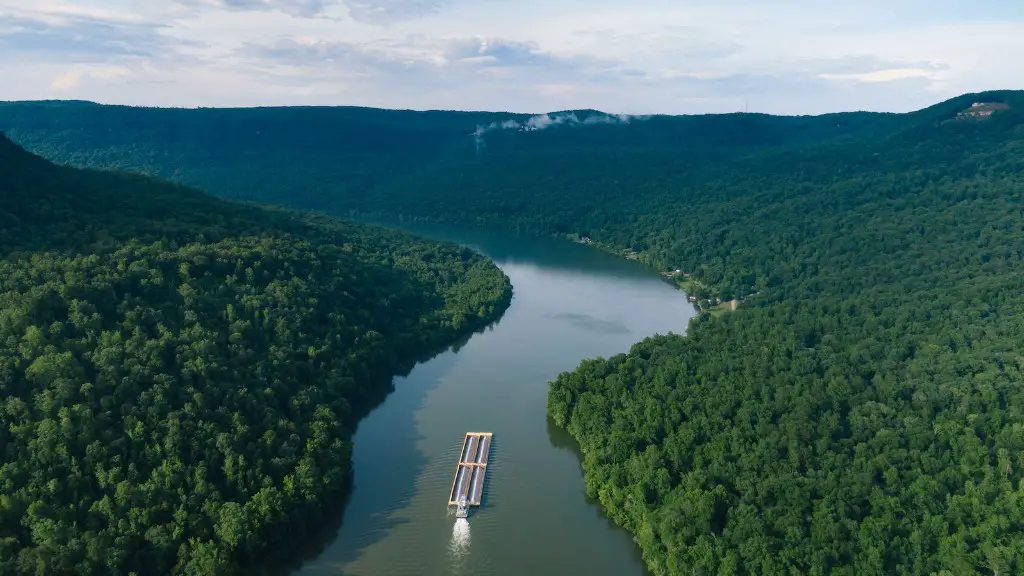The Yangtze River – the longest river in Asia and the third-longest in the world – is a major source of water, food, electricity, and irrigation for many communities along its banks from the Tibetan Plateau to the East China Sea. It is an integral part of the country’s transportation system and serves an important role in the nation’s economy. As the Yangtze River flows eastward, its characteristics change in notable ways.
The Yangtze River’s total length is approximately 6,380 kilometers, more than 200 kilometers longer than the Nile River in Egypt. Its source is in the west in Qinghai on the Tibetan Plateau, and the river descends in elevation as it flows eastwards. From the Tibet-Qinghai Plateau, the river flows through the provinces of Shaanxi, Sichuan, and Hubei and then passes through the cities of Chongqing, Wuhan, and Nanjing before flowing out into the East China Sea. From source to sea, the river’s elevation falls from a base of around 5,200 meters to zero at the sea.
As the river flows, its physical characteristics change. For example, its water volume and sediment load increase. The sediment load increases from about 40 million tons at the headwaters to about 270 million at its lower stretches. A significant portion of this sediment is made up of rocks and boulders that have been eroded from the surrounding mountains by the river’s tremendous power, and it contributes to the formation of numerous shoals, rapids and islands along the course of the river.
The Yangtze River’s ecosystem is also very different downstream. The downstream environment is much more heavily populated than the upstream environment, and the water quality changes accordingly. The increasing water pollution, which includes industrial and agricultural waste, has caused a decrease in oxygen levels, damaging the river’s aquatic habitat and adversely affecting species that live in the river. A decrease in biomass – the amount of living material in a given space – has been observed at various points along the river due to overfishing and other unsustainable practices.
A key factor in the Yangtze River’s transformation is the construction of numerous dams along the river’s course that regulate the flow of water. These dams allow for improved access to water in the downstream regions, making them important to the lives of millions of people. However, they also have an ecological cost, as they create drastic changes in the flow of the river, often preventing large amounts of sediment from moving downstream and interrupting the river’s natural cycle.
Finally, the impacts of climate change and increased human development along the Yangtze River’s banks have caused dramatic changes to the river. The summer monsoon season is becoming more intense, resulting in extreme floods and droughts, and deforestation and other human activities are increasing the amount of silt that enters the river, further reducing water flow and quality.
Impacts of change in the Yangtze River
The changes in the Yangtze River have had a significant impact on the lives of people who live along its banks. The river’s dams have enabled better access to water for agricultural activities, but also have caused great disruption to local ecosystems and the livelihoods of many people. The increasing water pollution has caused tremendous damage to aquatic habitats and species, with some species on the brink of extinction. The river has also been used as a dumping ground for industrial and agricultural waste, leading to increased levels of toxins and hazardous chemicals present in the water.
In addition, changes in the river’s water flow, increased flooding and droughts, and silt accumulation in downstream areas have all led to a significant disruption of the lives of those who rely on the river for their livelihoods and has caused a noticeable shift in the river’s economic, physical, and ecological conditions.
The Chinese government has taken some action in recent years to mitigate the effects of change in the Yangtze River, such as implementing regulations to prevent illegal dumping, expanding environmental protection projects, and constructing Nature Reserves and spawning grounds in key areas of the river.
However, the magnitude of the problems associated with the river remains a daunting challenge. Despite such efforts, experts believe that more needs to be done to ensure the sustainable future of the Yangtze River and its surrounding environment.
Environmental Solutions for the Yangtze River
In order to ensure the sustainable future of the Yangtze River, there are several steps that need to be taken. Firstly, the Chinese government needs to implement stricter regulations to prevent industrial and agricultural pollution, which is the primary cause of the river’s poor water quality. In addition, it needs to strengthen their efforts to preserve and restore the river’s aquatic habitats and species, reduce silt accumulation, and improve the functioning of its dams.
The construction of nature reserves, the implementation of projects to prevent soil erosion, and the implementation of water-saving methods in agriculture can also help reduce pressure on the resources of the Yangtze River. Furthermore, local communities should be informed about the dangers posed by overfishing and should be provided with economic incentives to promote responsible fishing practices.
The Chinese government should also strive to raise public awareness about the environmental threats posed by climate change and human development and work together with the other provinces and cities affected by the Yangtze River to find effective solutions.
Finally, improved protection and management plans for the Yangtze River need to be implemented to ensure its long-term sustainability. These should include comprehensive data collection and analysis, strict enforcement of regulations, and open dialogue between all stakeholders to ensure that the Yangtze River receives the attention, care and protection it deserves.
Government Regulations
The Chinese government has implemented several regulations to protect the Yangtze River, such as banning certain types of boating, imposing limits on water pollution, and protecting certain aquatic species. These regulations are important, but they are not enough to ensure the long-term sustainability of the river.
The government also needs to increase public awareness about the importance of preserving the river and its surrounding environment. This can be done by providing environmental education in schools, by encouraging environmental stewardship and climate change mitigation efforts, and by strengthening enforcement of existing regulations. Furthermore, the government should strive to ensure that all stakeholders, including local communities and businesses, are aware of and comply with regulations.
International organizations also need to take an active role in promoting the protection and sustainable use of the Yangtze River. The United Nations Environment Programme recently launched the Unite for the Yangtze, an initiative to support and finance local conservation efforts. It is important that similar partnerships are established between the Chinese government and other stakeholders in order to ensure the long-term sustainable management of the river.
What Can We Do?
Individuals, too, can play a role in protecting the Yangtze River. One way is by being an informed consumer and choosing products that are sustainably sourced and produced. In addition, people should strive to reduce their personal water footprint by being mindful of water usage in daily activities such as taking shorter showers, using low-flow faucets, and using rainwater collecting systems. They can also spread the word to raise awareness about the importance of the Yangtze River and its need for protection.
Finally, individuals can support local and international initiatives aimed at preserving the Yangtze River and its surrounding environment. This includes supporting organisations that are working to restore aquatic habitats, protecting biodiversity along the river, and collaborating with local communities to establish sustainable and conservation-minded practices.
Conclusion
The Yangtze River plays an important role in the lives of millions of people, and its health is closely intertwined with the health of China’s economy and environment. The various changes the river has undergone over its long history, from the impact of climate change to the construction of dams, have had a tremendous impact on its environment and those who live along its banks. To ensure the Yangtze River’s long-term sustainability, the urgent need for better regulations and responsible practices must be addressed. If we are to protect this important river, it is clear that this needs to be done not only by governments and corporations, but by individuals as well.





